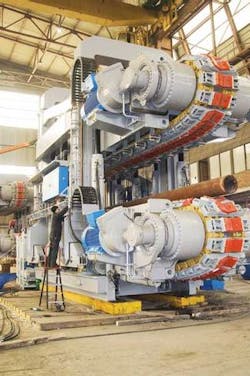Need for flexibility imposes greater demands on pipeline winch/tensioning
Pipelay contractors are responding to the global surge in field development. With so much activity in all water depths, contractors continually are bolstering their fleets with newbuild or converted pipe- and flexi-lay vessels.
Tensioning equipment specialists are working hard to meet demand and to adapt systems for extreme laying conditions. As an example, SAS Gouda was commissioned by a US contractor to supply a 400-metric ton flex-lay system and 450-metric ton A&R winch.
The equipment is for a cable lay vessel undergoing conversion to perform both S-lay of 60-in. concrete-coated pipes in shallow water and smaller diameter polypropylene pipes in deeper water. SAS Gouda’s previous record deliveries were the 350-metric ton tensioners for last year’s upgrade of Allseas’Solitaire and a 300-metric ton A&R capstan winch, part of a flex-lay system for Subsea7’s Kommandor-3000. In this case, the vessel was upgraded for new work on Brazil’s Roncador field.
SAS Gouda addresses the load requirements of its latest project in several ways, says Managing Director Raymond Kerkvliet. “For laying concrete-coated pipes, the tensioner tracks need to incorporate a suspension system to allow passage of diameter irregularities, relating to items such as anodes and buckle arrestors.
“With conventional tensioners, this is achieved by supporting the track rollers via individual springs that allow the rollers to follow the shape of the pipe. But with high loads, this spring system is inadequate, and it therefore must be replaced by hydraulic cylinders. In this case, pressure can be set to the required set-points, depending on the type of pipe to be laid and the associated water depths.”
Under deepwater conditions, the combination of high loads and the slicker polypropylene coating demands a system that can grip the pipe and then retain it. “For this purpose, we have designed a special shoe, consisting of high-friction material with an enhanced contact surface.
“Four-track tensioners generally are more effective for gripping products such as flexibles, umbilicals, and cables under high tension loads. For concrete-coated pipes, two-track tensioners are more appropriate. But there might also be size constraints, as was the case on theSolitaire. Here, the existing two-track tensioners had to be replaced, while a four-track tensioner would have been too wide to fit the existing envelope.”
Typically, SAS Gouda designs tensioning machines with chains internally driving the tensioner tracks. For theSolitaire re-vamp, however, system dimensions were constrained by project requirements. Normally, SAS would opt for larger diameter chains, but in this case it had to take the biggest chain available in the Caterpillar product range.
“This chain underwent thorough destructive testing, with Allseas’ assistance,” Kerkvliet explains, “to establish actual safety factors. The end-results showed that there was a sufficient safety margin.”
Solitaire is being upgraded to allow it to lay 24-in. polypropylene pipes in S-lay mode in water depths to 2,700 m, as well as rough concrete-coated pipes. Under the current Stage 2 program, SAS supplied three 350-metric ton systems that raise overall tensioning capacity to the 1,050 metric tons needed for future ultra-deepwater installations.
SAS is not involved on Allseas’ latest conversion project, the deepwater pipelay vesselAudacia. Indirectly, however, it did supply the tensioners, as these were the ones removed last year from the Solitaire.
Stinger first
Among other current projects, for the first time the company is supplying a virtually complete pipelay package, including stinger and davits, for a new derrick lay barge under construction at the Labroy shipyard in Indonesia. The barge will be owned by Singapore-based Ezra Marine Services, and should enter service in March 2007.
The double joint system will be controlled by two 100-metric ton tensioners, and a 220-metric ton A&R winch with associated sheaves, controls, and power supply. SAS also supplies pipe handling and coating equipment, capable of handling 6-52-in. concrete-coated pipes. As for the 68-m long fixed stinger (again, an SAS design), this will be an articulated system, positioned at an angle of 40 deg for deepwater pipelay. At 200-m water depth, the barge will be able to lay pipes up to 35-in. diameter. In deepwater mode, the limit will be 960 m for 24-in. pipes with tension loads of 200 metric tons.
Another novel contract - in terms of the destination, though not the overall scope - was the provision of a 100-metric ton pipelay system for a 135-m long vessel owned by Russia’s MRTS. This has been converted from a transportation barge, which this summer was due to start operating in Varandey Bay off northwest Russia, just south of the Barents Sea.
Project design consultant Gusto MSC provided conceptual and basic design for the conversion - the barge was towed last year from China to Rotterdam. It is scheduled to lay two 36-in. pipelines from the coast to a single point offloading terminal, 18 km offshore, in 22-m water depth. The terminal will offload crude produced in the tundra region to shuttle tanker for onward shipment to Murmansk or Rotterdam.
The SAS equipment includes a 100-metric ton pipe tensioner, a 100-metric ton A&R winch, and the complete pipe handling system. According to Kerkvliet, one main challenge was delivering the package on time last December - within five months of contract award - to meet the operating window criteria. “Also, the very low temperatures off northern Russia will have an impact on equipment materials, so parts of our package needed special certification.”
To improve future deliveries, SAS invested in new project management software. “With this new capability,” Kerkvliet explains, “purchasing and fabrication can be monitored in extensive detail. Additionally, we gradually brought in new 3D software linked with calculation models such as finite element analysis. With all our drawings now 3D, we get a better insight into the equipment and its structure.”

